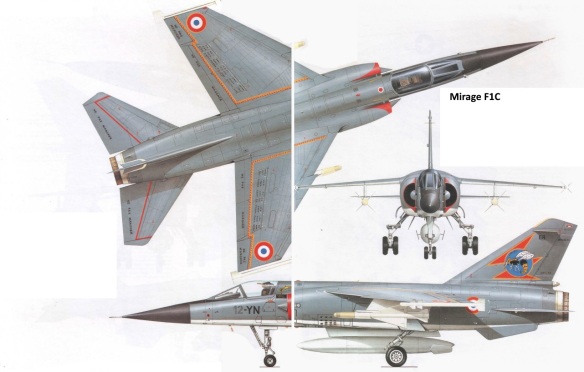When developing a successor for the popular Mirage III, Dassault dropped the tailless delta configuration and instead adopted a conventional swept wing for its Mirage F1.
In 1964 the French Government awarded a development contract to begin work on an all-weather interceptor. Work was initially on the Mirage F2, a 20 tonne class fighter powered by a TF306 turbofan. At the same time though Dassault worked on a private venture fighter that was similar to the F2, but smaller overall and to be powered by an Atar turbojet. This design was the Mirage F1, which flew in a privately funded prototype form on December 23 1966.
The Mirage F1 was not a great technological advance, yet it was quite a big improvement over the Mirage III, in that the Atar 9K-50 was considerably more powerful, it had 43% more internal fuel (doubling the ground attack radius), improved maneuverability, 30% better field performance, slower approach speed and an improved Cyrano IV radar.
Production of the F1 began with 100 F1C interceptors for the French Air Force, which were delivered from May 1973. From 1977 deliveries to the French Air Force were of the F1C-200 which introduced a fixed refuelling probe and a minor fuselage stretch. Fifty five F1Cs have now been modified for ground attack as F1CTs.
France also took delivery of 64 reconnaissance F1CRs fitted with infrared linescan installed in place of cannon, optical cameras in a small nose fairing, and various centreline recce pods. Also in French service are two seat F1 Bs – with less external fuel and a slight stretch.
The Mirage F1 has been exported widely, mostly F1Cs. The F1A is simplified for day ground attack without the Cyrano radar, while the multirole F1E and equivalent F1D two seater achieved some success.
Type: Multirole fighter
Powerplant: F1C – One 49.0kN (11,025lb) dry and 70.2kN (15,785lb) afterburning SNECMA Atar 9K-50 turbojet.
Performance: F1C – Max speed 2338km/h (1262kt). Max initial rate of climb 41,930ft/min. Service ceiling 65,600ft. Combat radius with 14 250kg (550lb) bombs, hi-lo-hi 425km (230nm), or lo-lo-lo with one AM39 Exocet anti shipping missile and two drop tanks 700km (378nm). Combat air patrol with two Super 350 AAMs, one underfuselage tank and one combat engagement 2hr 15min.
Weights: F1C – Empty 7400kg (16,315lb), max takeoff 16,200kg (35,715lb). Dimensions: F1C – Wing span without wingtip missiles 8.40m (27ft 7in), length 15.30m (50ft 3in), height 4.50m (14ft 9in). Wing area 25.0m2 (269.1 sq ft). F1C-200 – Same except length 15.30m (50ft 3in).
Accommodation: Pilot only, or two in tandem in F1B.
Armament: F1C – Two 30mm DEFA 553 cannon in lower fuselage. Theoretically can carry 6300kg (13,890lb), or in practice 4000kg (8,818lb) of ordnance on four underwing, one centreline and two wingtip hardpoints including wingtip AIM-9 or Magic infrared guided AAMs, R. 530 or Super 530F radar guided AAMs, rockets, bombs and ASMs, including the AM 39 Exocet, or Armat anti-radiation missile.
